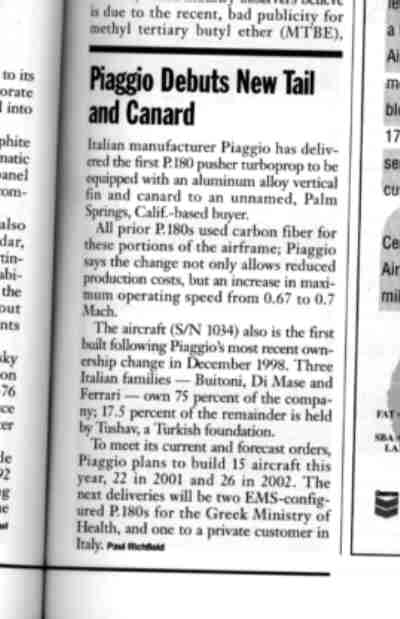

Aluminum vs Composite Construction
![]()
The Meyers™ 200D is constructed of aluminum over a steel framework. Aluminum construction has the great advantage of years of reliable data on fatigue and stress. It, likewise, remains the metal of choice for commercial airlines and military aircraft. Many experts feel that aluminum construction will remain the mainstay of aircraft materials for the foreseeable future.
![]()
Aluminum - Advantages
A. Predictable strength which is certified by the manufacturer of the metal and which is recorded with each batch.
B. The metal conductivity enables a single wire electrical system to be used which saves weight and complexity.
C. The metal conductivity maximizes antenna reception and transmission.
D. Recognized lightning strike properties and protection.
E. Minimal UV degradation from sunlight.
F. Controllable moisture problems such as corrosion.
G. Will transmit loads and can bend without failure.
H. Good bonding techniques can eliminate P-static for better radio reception.
I. Smoothness of construction is pre-determined; no extensive sanding or filling is required.
J. Paint chips do not materially effect the integrity of the underlying aluminum.
K. The FAA readily accepts it as a construction medium and is knowledgeable about its physical properties causing minimal delays in the certification process.
![]()
Aluminum- Disadvantages
A. Form blocks must be built to hydro-form the metal in a soft state which then has to be heat-treated to gain its strength back.
B. Due to the setup of the hydro-form process, there is a high per unit part cost unless large batches are produced at one time, in which case, inventory carry costs increase.
C. Thin aluminum, as used in general aviation aircraft, cannot be compound curved and still carry structural loads, thereby increasing drag in some areas if improperly engineered.
D. Antennas need to be exposed for proper operation, necessitating the use of very expensive, low drag antennas for high speed.
E. It is almost impossible to build laminar flow wings with the skin thickness used in general aviation aircraft.
![]()
Composite Construction
Composite construction utilized in most kit-built planes has been touted in the past as the wave of the future but has been shown to not be the answer in all cases for aircraft construction. Many of the better current designers feel that composites are not viable for the long term in today's market.
![]()
Composite Construction - Advantages
A. Ease of construction in small lots. These planes are typically assembled by individuals in their garages.
B. Low cost for one-off projects as minimal tooling is required.
C. Can be compound curved for maximum drag reduction and still carry structural loads.
D. Electronic transparency means antennas can be hidden inside for streamlining without loss of reception.
E. Easier to get smooth surfaces for laminar flow designs which contributes to some additional speed.
![]()
Composite Construction - Disadvantages
A. Strength varies from batch to batch. Difficult to detect voids.
B. Since there is no metal frame, there is no common ground and a two wire electrical system is required.
C. Without any electrical conductivity there is very poor lightning strike protection.
D. Ultraviolet light degradation due to sunlight.
E. Delamination problems due to moisture.
F. Composites tend to break without warning at failure loads, unlike aluminum which can bend and still survive and usually provide some warning prior to failure.
These pictures were taken from AvWeb's site. The Velocity made a bad landing and skidded off the runway into the tie-down area. The Cessna 340 was tied down and not running at all. The Velocity simply slid into the Cessna.
Doesn't look too bad here.
The caption was "Aluminum 1 - Composites 0"
The Cessna was tied down, not moving nor were its engines running.
Minor damage to the Cessna.
It will fly again with a new prop spinner and radome but the Velocity is probably history.
See the difference?
G. Poor electrical bonding causes static interference with radios.
H. Many labor hours are necessary to get the desired smoothness. The average build time is around seven years.
I. Requires expensive paint kept in perfect condition without chips or scratches to keep sunlight and moisture out; otherwise composites degrade like an old fiberglass boat. Both Lancair and Cirrus require special paints and limit colors per the Type Certificate Data Sheets. To see the Cirrus TCDS in pdf format, Click Here. To see the Lancair TCDS in pdf format, Click Here.
J. Poor acceptance by the FAA due to the unknown physical properties like aging and delamination. The Lancair Columbia 300 has an airframe life limitation of 1200 hours. The Cirrus SR20 has a 12,000 hour life.
K. Very labor intensive to construct repeatable components.
To sum up what we at Meyers Aircraft Company have determined, we will quote from a Boeing engineer as stated in a recent Aviation Consumer article, "The more we learn about composites, the better aluminum looks."
![]()
The following was added March 14, 2000
One more verification of our Analysis
The following article appeared in the March 2000 issue of BCA.

Notice in paragraph two it states, "Piaggio says the change (from composite to aluminum, ed.) not only allows reduced production costs, but an increase in maximum operating speed from 0.67 to 0.70 Mach." Is there much more that needs to be said! This is empirical proof of the validity of our analysis.
![]()
Paul M. Whetstone, President
Email pwhetstone@meyersaircraft.com
Meyers Aircraft Company, Copyright © October 1999. All rights reserved. Reproduction in whole or in part of any text, photograph or illustration without written permission from Meyers Aircraft Company is strictly prohibited. Disclaimer: The information presented herein is believed to be accurate and at times expresses the opinions of management. Meyers Aircraft Company assumes no responsibility for its unauthorized use. To report problems or missing links, contact webmaster@meyersaircraft.com